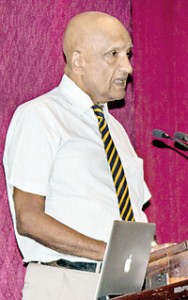News
Docs sans stethoscopes is his vision
View(s):Doctors without stethoscopes, is what veteran teacher and clinician of Peradeniya-fame, Prof. T. Varagunam is predicting. Stethoscopes will vanish in about 10 years, he prophesied last Wednesday adding that doctors will be armed with echocardiograms. Delivering the ‘History of Medicine Lecture 2014’ on ‘Clinical Practice’ at the Sri Lanka Medical Association (SLMA), Prof. Varagunam known to his beloved students as ‘Muggy’ along with Prof. K.N. Seneviratne aka ‘Bull’ are dubbed the “most respected and popular teachers” of the golden years of the Peradeniya Medical Faculty in the 1960s and 1970s. The introduction of Prof. Varagunam is spotted with many firsts. Hailing from Batticaloa, he had received his secondary education at Royal College, Colombo, marking his presence there by being a hooker on the rugby team, when it won the Bradby against Trinity College, Kandy, for the first time in 1948. (His love for his college is obvious, even so many decades later, for as he walks up to the lectern, he sports a blue-and-gold striped tie of his alma mater.)

Prof. Varagunam delivering the ‘History of Medicine’ Lecture
This respected teacher is also the first Sri Lankan to study medical education at Illinois University, Chicago, United States of America, after having passed out from the Colombo Medical Faculty and undergoing postgraduate training in the United Kingdom.The other firsts include: Setting up the Medical Education Unit of the Peradeniya University; returning from a World Health Organisation stint in Geneva to take up duties as Chancellor of the Eastern University and founding the first Medical Faculty in the Eastern Province; and having the “unique distinction” of being the President of the Kandy Society of Medicine twice.
Having been a clinician for 60 years, “with first-hand knowledge” not only in Sri Lanka but also elsewhere, his “uniqueness” as spelt out as never losing his passion to learn and then impart that knowledge to his students. Brief, to the point and simple is his lecture giving a pointer to his prowess as a teacher. Clinical practice, explains Prof. Varagunam, is when the patient meets a doctor (clinician) who is in the profession of helping the sick and reducing their symptoms.The changes which have occurred in clinical practice hinge around two main aspects – numerous research being carried out and global access to the internet, according to him.
With regard to research, he cites estimates of 1.5 million research papers being produced annually by 2020, while pointing out that internet use is rising rapidly. In Sri Lanka, according to a World Bank report, there were 18.3 per 100 people accessing the internet in 2012 while in the United Kingdom it was as much as 87 per 100.
These two factors have brought “big changes”, he reiterates, creating an image of what happens when a doctor meets an outpatient or inpatient. With the doctor will come his cognitive style, very individualistic, like the way he walks. The patient comes with knowledge, attitude and anxiety.Over the years, the professional cognitive style has changed from being intuitive to analytical, points out Prof. Varagunam, explaining that intuitive style was the result of instinctual insight gained from knowledge, common prior to 1950, with no attempt at analysis of a condition assailing a patient.
A “classic example” takes the audience to the Colombo General Hospital of yore – the late Dr. Cyril Fernando in his three-piece suit and gold watch-chain, would walk into the ward where the students would be gathered, and tell the Sister, “I smell typhoid”. And he would be right, with several cases of typhoid being in the ward, says Prof. Varagunam. However, analytical style became more common after the 1950s, as knowledge increased.
Another much-quoted example of intuitive style, he cites, is how a Junior Registrar on seeing the famous nude of a woman painted by Rembrandt in the 1600s, hanging in the Tate Gallery, spot-diagnosed that the woman had breast cancer. Going back in time to the records of that period, his diagnosis had been found to be correct.
More examples flow forth of Dr. James Parkinson who described Parkinson’s disease, which was not analytical but more descriptive, “between thought and action there is a considerable time lapse”; Sir William Gowers who said that Parkinson tremors in the fingers resembled “orientals beating their small drums” and William Heberden gave a classical description of angina pectoris still considered valid on how such patients feel.
“Many experienced doctors used the intuitive style, says Prof. Varagunam, detailing how analytical thinking came about later with greater knowledge backed by research. The olden-day doctors with intuitive style would be conservatives, dressed formally, while Prof. Varagunam’s cardiologist is the new breed of doctors, met patients in his scrubs but was armed with analytical knowledge.
The “remarkable changes” have come about due to increased research and development which have brought in their wake practice of evidence-based medicine; practice of personalised medicine based on genetic analysis; precise location pathology by new imaging techniques (“can image and say what a person is thinking depending on the area of the brain that is active”); and vastly improved diagnosis methods.
Most patients are also aware of what they have. This is why traditional medicine will disappear, with gadgets changing the practice of medicine. Technology making a “massive difference”, now patients and doctors seem equal participants. You don’t “give” a patient medicine but “offer” it to him and it is up to the patient whether he will take it or not, he says.
Stressing that research on the spot has changed clinical practice vastly, Prof. Varagunam adds that doctors now need only smart-phones with apps to come to an analytical diagnosis. The ‘History of Medicine’ Lectures inaugurated three years ago commemorate the founding of the SLMA on a day like Wednesday, 127 years ago.


